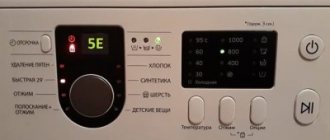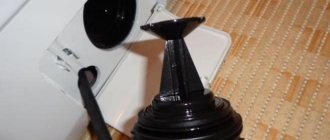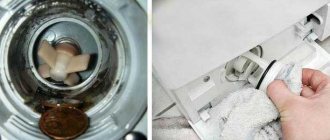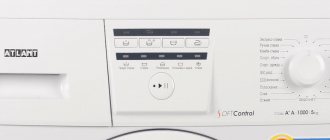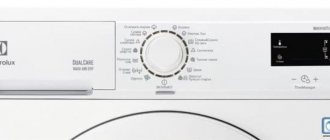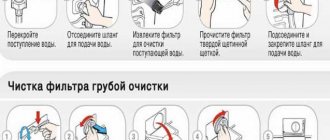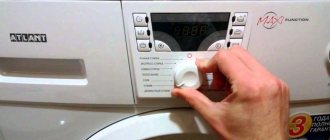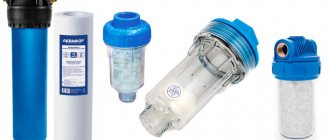Cleaning instructions
Washing machines have two debris filters: inlet (inlet) and drain (drainage). The first one purifies the water coming from the water supply into the machine from the impurities it contains (rust, sand, etc.). The second prevents small items that might have been loaded into the washing machine along with laundry from getting into the drain pump.
If there were no drain filter, the drain pump would instantly fail, and blockages would appear in the drain hose.
You can clean the garbage filter yourself; there is no need to call a professional for this. Follow the instructions clearly, this will help you avoid various troubles: from a dirty puddle on the floor to bringing the machine into a completely faulty state.
The first question that arises is: where is the filter on the Kandy machine? It can be found at the bottom - in the front left part of the case. It is covered by a special camouflage panel or a hinged lid, directly behind which there is a hatch. Having found where the filter is located, you need to follow these steps sequentially:
- To gain access to the location you need, move the machine and lift it slightly if necessary. Remove the decorative panel or open the hatch cover. To do this, it is convenient to use a wide knife or a flat-head screwdriver. The closing element is pulled towards itself or moved to the side.
- In washing machines, only in the drum there is no water at all. A small amount of liquid always remains in the system. When dismantling the filter, it will spill out, so place a container under the hole and cover the floor with a rag. If there is an emergency hose, remove it and drain the water.
- Remove filters. To remove the inlet filter, you just need to unscrew the hose; the mesh can be cleaned without removing it, or carefully pulled out using tweezers. The drain filter is closed by a plug; it must be unscrewed. Unscrew the screw fasteners with a screwdriver and pull out the filter completely.
- Clean the filter. Remove large fractions of debris from the filter, rinse the mesh under running water. To prevent rubber seals from becoming deformed, rinse with warm water, not hot.
- Using a flashlight, examine the filter hole and pump pump. Clean the impeller from dirt and objects that have fallen into it. The impeller should rotate freely.
- Place the pump filter in place by carefully assembling it and tightening all screws.
- Test the machine by plugging it in and running the rinse cycle. While the machine is running, carefully observe for leaks. If the machine is leaking, it means something was installed incorrectly.
- Replace the masking panel or close the hatch cover. If the machine was moving, move it to its original position.
How to clean the mesh filter yourself - instructions
The cleaning procedure is quite simple, does not require special knowledge and experience, and even a woman who is not familiar with the structure of a washing machine can handle it. The main thing is to follow the sequence of steps described below.
- Unplug the washing machine and close the water supply shut-off valve to the machine.
- Unscrew the washing machine inlet hose and disconnect it from the body to gain access to the filter. This is usually easy to do with your hands, but if you are not strong enough, use pliers or pliers. There is always some water left in the hose, so slip a rag when unscrewing the hose if you don’t want any remaining water on the floor.
- Gently clamp the filter with pliers or pliers and pull it towards you; it will come out easily.
- Rinse the mesh under running water. If you want a more thorough cleaning, soak it in a solution of citric acid for 30 - 60 minutes (at the rate of 1 teaspoon per glass of warm water). Please note that the water should not be hot. Boiling water can cause the plastic to deform, in which case you will have to change the fill filter. Warm water is preferable to cold water because citric acid dissolves better in it.
- Insert the screen back into the fill valve hole until it stops using pliers or pliers.
- Screw on the inlet hose, fully open the water supply tap to the machine and check that the connection point of the hose to the washing machine is not leaking.
- Plug in the washing machine, run any program and make sure the machine fills with water.
We suggest you read: How much mercury is in a thermometer and what to do if it breaks?
What to clean with?
Sometimes a situation arises when the filter cannot be cleaned with water alone. This usually happens if a lot of time has passed since the previous cleaning. What to do with a heavily soiled filter?
In this case, use additional funds. Pour warm water over soda and citric acid at the rate of 20-50 g per liter of water. This solution helps remove scale, rust and mucus. Soak the filter parts in it for a maximum of half an hour, then rub with a sponge and rinse with water. If the plaque is insignificant, it can be cleaned with toothpaste or laundry soap.
Instead of soda and citric acid, special solutions that remove rust are suitable.
Can't unscrew
Sometimes it is not possible to unscrew and remove the filter due to various objects stuck in it. Hair, socks and handkerchiefs, coins, beads and other small items during washing can end up in the catcher in front of the pump and plug it. Limescale deposits on the threads, which occur if the filter has not been removed for a long time, can also become an obstacle.
In this case, there are three ways to open the garbage filter. Apply them in turn, proceeding to the next method only if you tried the previous one and it did not help. Before you begin, be sure to unplug the machine and close the valve to prevent water from flowing.
1 way. Use pliers or pliers to unscrew the filter cap. There is a handle on it that you need to try to turn using a tool. Manipulations should be carried out very carefully so as not to break the filter part.
Method 2. Lightly tap the drain pump filter cover several times while tilting the washing machine. This method is suitable when:
- The garbage filter cover does not rotate at all;
- partially rotates;
- It can be unscrewed, but it cannot be removed.
Tilt the machine back and lean it against the wall. Tap the dust filter cover and the housing next to it. If the snag is in small objects that have stopped the desired part, then the knock will cause them to move, and you can unscrew and pull out the filter.
3 way. If the previous two methods were unsuccessful, then you need to completely remove the drain pump. The task is to clean the snail and remove the filter. This method is quite complicated - you need to get to the pump, unhook the pump from the volute and through the resulting hole get to the filter.
The design features of certain models of Kandy washing machines allow the drainage pump to be dismantled through the bottom. If it is easily removed or is absent altogether, then it is easier and more convenient to get the snail with the pump in this way. Putting the machine on its side or simply tilting it in the desired direction and resting it on the wall, remove the bottom and find the pump. It is located behind the filter, that is, in the lower part of the housing.
The listed methods should only be used if you are confident in your abilities and have certain skills in repairing various devices. If the filter does not unscrew and you are not very well versed in technology, it is better to call a specialist. It must be remembered that through ignorance you can not only waste time, but also worsen the situation.
Interesting:
- Share your opinion - leave a comment
Many people don’t even realize that washing equipment has a drain filter. It is usually hidden behind the plinth panel and does not attract attention to itself. Still, the part needs to be cleaned periodically, so it’s useful to know how to unscrew the filter in a washing machine.
How to open the filter cover in a washing machine?
Foreign objects in pockets, small debris, hair and threads do not disappear without a trace after loading things into the drum. All this passes through the drain filter, pump and, in the best case, goes into the sewer. It also happens that debris clogs the parts and blocks the pump. The problem is accompanied by the following symptoms:
- the machine does not completely drain the water;
- operation stops and an error code appears on the display;
- Water leaves the tank slowly and intermittently, while the pump’s hum and crackling noise can be heard.
Ideally, the filter should be cleaned once a month. If the user follows the instructions, then no problems arise - the element is easy and simple to get. Just open the panel:
- In the Samsung, LG, Zanussi, Kandy, and Atlant washing machines, the filter is hidden behind a small door under the loading hatch. Press the door with your hand or pry it with a screwdriver to gain access to the part.
- In Bosch machines, the element is hidden by a long decorative panel at the bottom. In earlier models, the lid is attached to hooks. Install them horizontally using a screwdriver and remove the panel. In the latest models, the latches are pressed with a slotted screwdriver, and the door is moved to the side.
- In SMA "Ariston", "Indesit" there is also a solid panel. Immediately press the lower, then the upper latches and remove the filter.
Important! Some washing machines (especially the vertical type) do not have a drain filter. Here the pump, pipes and hoses are cleaned.
Now you can move on to cleaning the elements. But here, too, problems occur. The next section will help you solve them.
Where are the drain and fill filters located?
The location of the filters for most household washing units is the same. The filling filter element is installed in the rear (top) part of the washing unit, directly on the inlet fitting of the water supply valve.
The drain filter must be looked for at the lowest point of the washing machine; it is there that the water can be drained by gravity in the event of an emergency. Most often, access to it is closed by a special hatch or decorative panel; for ease of maintenance, it is located in the front part of the machine. In the same place there may be a small-diameter emergency drain pipe with a plug at the end in the form of a plug. This tube is designed for emergency drainage of water from the washing machine tank.
Features of the location of the drain filter from different manufacturers
The main criterion that manufacturers follow when installing a drain filter is easy access to it for maintenance. It can be located on the front (most models) or side (for example Samsung) side. Typically, the pipe into which the filter element is screwed is made together with the drain pump body; when the pump is removed, the element itself is accordingly removed. In order to get to it, you must either remove the decorative trim, or open or slide a special door.
Why can’t I unscrew, remove and remove the filter?
The main reason is foreign objects. Lint, wool, hair, small foreign bodies, handkerchiefs, napkins, socks fall into the trap in front of the pump and tightly block its movement in the cochlea.
More rarely, removing the washing machine filter is made difficult by scale deposits on the threads. It forms if it has not been cleaned for a long time.
We recommend! Once every 2-4 months, clean the filter from debris and foreign objects. Detailed instructions are in the article “How to clean the filter in a washing machine.”
When is cleaning necessary?
The manufacturer of Atlant washing machines requires regular (once every three to four months) cleaning of the drain filter.
If for some reason the frequency of cleaning the filter element has been violated, the washing machine will remind you of this with an unpleasant smell of washed clothes (accumulated debris is an excellent breeding ground for bacteria, fungi and mold).
Also, the fact that the filter element needs to be cleaned urgently will be indicated by difficult draining (remains of water in the tank after washing is a clear sign that the filter element requires cleaning).
Failure to clean the drain filter element may cause the drain pump to break down. Small particles of debris penetrate through the dirt-covered filter into the drain pump, causing serious malfunctions (the impeller blades are damaged, the pump body is deformed), requiring long-term, expensive repairs. In the worst case scenario, the Atlant washing machine can be restored to operation only by replacing the faulty drain filter element.
Equipped with a self-diagnosis system, the Atlant washing machine signals that the drain filter element is clogged with an error code displayed on the control panel display.
What to do if none of the methods helped
This means that the washing machine filter cannot be removed due to scale or lime deposits from hard water. Follow the following steps one by one to resolve the issue. This will help minimize possible costs for new parts.
- the glass, soak the glass with the filter in a solution of water and citric acid to dissolve the lime. Or run a preventive wash with lemon juice if you have not yet had time to disassemble the pump. For soaking, you will need a container in which a glass with a filter is placed so that it is completely under water. Pour hot water, but not boiling water, in the region of 40-60°C to reduce the likelihood of damage to the plastic parts of the assembly and the rubber filter gasket. Pour about a tablespoon of citric acid onto the basin. You may need to weigh down the snail with the filter with something so that it does not float up after filling the container with water. Leave the filter to soak for 1-2 hours, then try to unscrew it. It’s not a fact that it will work, but if it works, you’ll save on new parts. The only thing that can be damaged is the rubber filter gasket. Acid can damage it, and then it will need to be replaced. A sure sign of gasket damage is leakage from the filter after reinstallation.
- Try to carefully break the filter out of the snail and install a new one . The plastic is quite fragile and can be cut with wire cutters, and then unscrewed and cleaned out the remains. Proceed carefully, do not damage the thread of the glass (snail). Otherwise, you will need to replace the entire snail, not just the filter. With damaged volute threads, the new drain filter will leak.
- Replace the snail assembly with filter . Immediately, if you don’t want to bother with unscrewing, or when you couldn’t carefully break off the filter. This will cost more than buying a gasket or a new catch filter. But replacement guarantees that the filter will not leak after installation.
If you read the article and realized that removing the washing machine filter yourself is an impossible task for you, then entrust this work to the RemBytTech specialists.
Pollution prevention
Every owner of washing machines needs to remember that only the use of preventive measures coupled with regular inspections can extend the life of household appliances. Need to:
- Soften the liquid. The harder the water resource, the faster scale accumulates. We recommend installing a special filtration system when connecting water supply (well or centralized) to the house. The kit should contain not only devices for coarse and fine water treatment, but also softeners. You can order such equipment at.
- Open the drain filter and clean it regularly. At least once every 6 months, but more often is better.
- Inspect laundry before placing it in the drum. Remove all trash from pockets. Use special covers for washing some clothes.
- It is worth “running” the machine with citric acid every 2-3 months.
